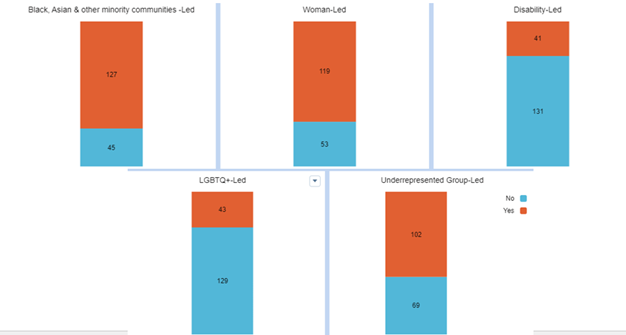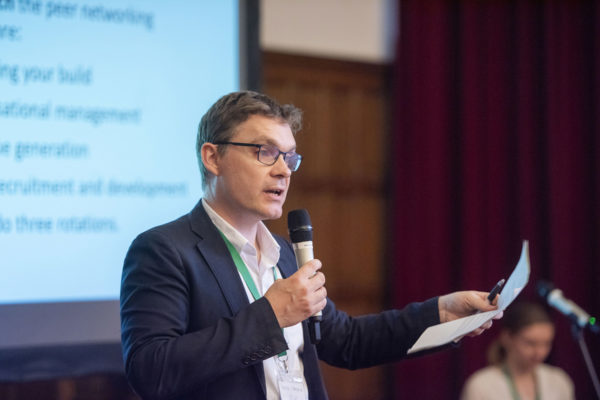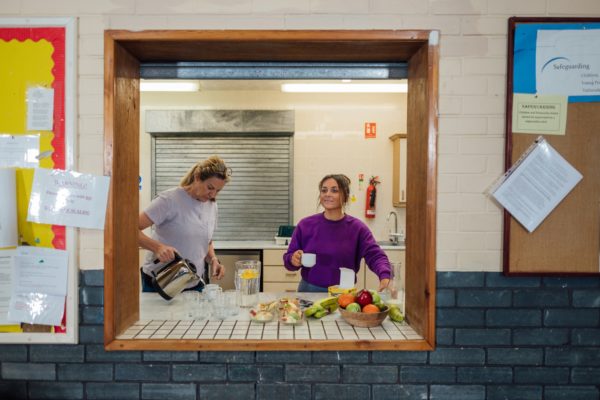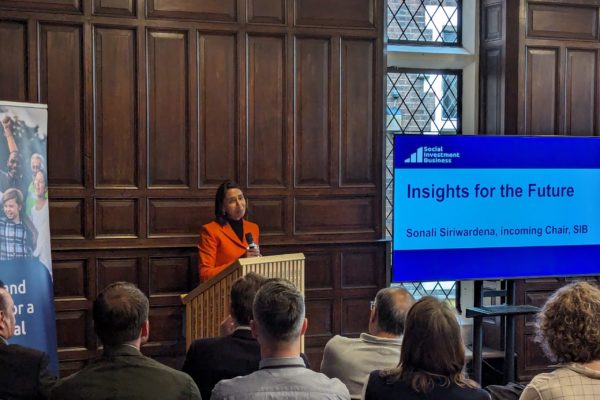A data-led approach
At SIB, we have been putting greater emphasis on using data to support decision-making in both our grant and loan funds, adapting our approach after considering a range of factors, including applicant demand, timelines, and partner requirements.
For the Future Camden Fund, with expectations of high demand and a short timeframe, we chose to make Stage 1 decision-making solely data driven, filtering a small group of organisations to Stage 2 using their application information to determine eligibility and to identify those most aligned to the priorities of the fund. This filtering was carried out using a Tableau dashboard built into SIB’s Salesforce system. Once moved to Stage 2, we used qualitative assessments for final decision-making.
Opportunities
As a new partnership, we were able to combine SIB’s knowledge of data and efficient systems for processing applications, with Camden’s expertise in and links to the Camden business sector. This resulted in some interesting opportunities as the fund developed:
Access and reach of underfunded groups
In Stage 1, the Future Camden Fund gained 172 applications – a success for both parties considering the short run up to the launch of a local fund. For both outreach and decision-making, the fund prioritised organisations from underfunded groups, including those from Black, Asian, and Minority Ethnic backgrounds, those with a disability and care leavers. The chart below shows the breakdown of leadership diversity amongst applicants. The diversity of these applicants is much higher than other traditional funds SIB runs (see Diversity Dashboard) and enabled the fund to ensure diversity in its reach.

Reaching a group that is traditionally underfunded is not enough for funders to do. Throughout decision-making, we prioritised supporting these groups. We did this in two ways (1) Filtering organisations through to Stage 1 only if they had declared being led by one of the 5 categories we had outlined as having diverse leadership. (2) Ensuring that we maintain that proportion of diversity amongst applicants in every stage of the decision-making process. For example, with 74% of all applicants being BAME-Led, we maintained up to 66% of all successful applicants were BAME-Led. Despite a slight drop mainly due to eligibility, this is good example of where we have been able to maintain accountability of our decision-making using data.


Gathering data to explore priority under-represented groups
Phase 1 was also a useful data gathering exercise to support valuable insights on the groups that the fund is trying to support – in this case, locally based, young, diverse and small businesses in Camden. Collecting data on such a large group of these organisations meant that we could begin to understand what types of challenges these organisations may be facing, what external factors could be shaping them and how to best support these organisations in the future. For example, this group of applicants had extremely low turnovers and number of employees (see the below chart). These insights will contribute to the design and development of the next phase of the Future Camden Fund.

Challenges
Accessibility of Application Form
On the completion of SIB’s application forms, the applicant is directed to a customer feedback form about the ease of the application form and general process. We were able to gain a high response rate with 64% of Stage 1 applicants completing our survey and 91% of Stage 2.
We provided an opportunity for organisations to provide a comment about how easy they find the application. Of those who provided a comment, 58% were positive, feeding into SIB’s understanding of best practice that is replicated across all funds. However, other comments revealed the challenges that some organisations struggled with our forms. Examples are below:

As we have learnt from application data, applicants were very young, and particularly small, with limited capacity to spend time on applications for funding. These were not the typical applicants SIB designs applications and guidance for, and this feedback demonstrates the need for more time and reflection on how SIB’s standard application questions and guidance should be adapted for different audiences. As we move forward into the design of phase 2, we will be scheduling more time to plan accessible guidance. This will include customer testing to understand suitability of information for the type of applicant we are looking to address for the next phase of the fund.
Moving Priorities
With a short timeframe to set up the fund, we needed to ensure that the application form and qualitative assessment collected the correct information to make a funding decision. One of the fund’s priorities was to support organisations that had a social purpose or an intention towards more social impact. However, the data showed that, although many applicants demonstrated an interest in becoming socially impactful in future, they did not currently have the capacity or size to achieve this goal. This proved challenging, shaping discussions in decision-making committees to truly reflect upon where our ‘red lines’ were for the fund, and the value of certain organisations that may not meet our expectations of organisations during the design stage. We recognize that we needed a clearer idea of where our priorities were in this pilot stage, to not move organisations into Stage 2 that did not meet them.
Moving forward to Phase 2
At the end of Phase 1, we have been able to fund 11 great organisations, disbursing £164,950. The London Borough of Camden are also working with Expert Impact to mentor these organisations to grow and succeed in their ambitions and School of Social Entrepreneurs to deliver business support.
As we prepare for Phase 2 of the Future Camden Fund, the learnings from Phase 1 have already informed how we plan for additional stages of the application process: including building in time for customer testing of our fund information and forms and prioritise design sessions that utilises the data we have collected in the first phase. We will be continuing to share the opportunities and challenges in this next design phase, ensuring ongoing improvements to the way we serve our customers.










